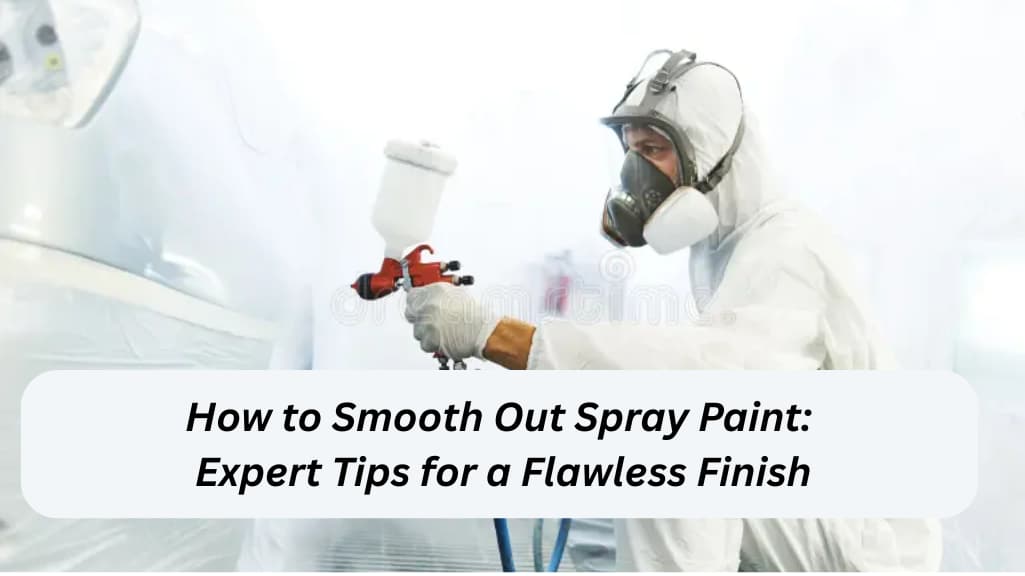Spray paint can transform objects with a fresh, vibrant look. Achieving a smooth finish requires patience and the right techniques. Start by sanding the painted surface gently with fine-grit sandpaper. This helps eliminate imperfections and prepares the area for a clear coat.
Always ensure the paint is fully dry before sanding to avoid smudging. After sanding, clean the surface thoroughly to remove dust. Apply a clear coat in even, light layers to seal and smoothen the paint. These steps ensure a sleek, professional finish on your spray-painted project. Proper preparation and careful application make all the difference.
Choosing The Right Spray Paint
Smoothing out spray paint starts with picking the right paint. The right choice ensures a smooth finish and fewer problems.
Types Of Spray Paint
There are many types of spray paint. Each type suits different tasks.
- General-purpose spray paint: Good for many surfaces. Ideal for wood, metal, and plastic.
- Rust-preventive spray paint: Protects metal surfaces from rust. Essential for outdoor items.
- High-heat spray paint: Withstands high temperatures. Perfect for grills and engines.
- Chalk spray paint: Gives a matte finish. Great for vintage or shabby chic projects.
- Metallic spray paint: Provides a shiny, reflective finish. Best for decorative items.
Factors To Consider
Picking the right spray paint means thinking about several factors.
| Factor | Why It Matters |
|---|---|
| Surface Type | Different paints work better on different surfaces. |
| Finish | Choose between matte, satin, gloss, or metallic finishes. |
| Drying Time | Quick-drying paint saves time. Important for multiple coats. |
| Color | Ensure the paint matches your project’s color scheme. |
| Durability | Long-lasting paint is ideal for high-use items. |
 Preparing The Surface
Preparing The Surface
Before you start spray painting, it’s crucial to prepare the surface. Proper preparation ensures a smooth, professional finish. This section will guide you through the essential steps.
Cleaning The Surface
Begin by cleaning the surface thoroughly. Dirt and grease can ruin your paint job. Use a mild detergent and warm water. Scrub the surface with a soft cloth. Make sure to remove all dust and grime.
- Rinse the surface with clean water.
- Let it dry completely.
- Use a tack cloth to remove any remaining particles.
Sanding Techniques
Sanding is a critical step to achieve a smooth finish. Choose the right sandpaper grit based on the material.
| Material | Recommended Grit |
|---|---|
| Wood | 120-150 |
| Metal | 200-400 |
| Plastic | 400-600 |
Follow these steps for effective sanding:
- Start with coarse grit sandpaper.
- Sand in circular motions to cover the surface evenly.
- Move to finer grit for a smoother finish.
- Wipe the surface with a damp cloth to remove dust.
Ensure the surface is smooth to the touch before painting.
Using Primer
Smoothing out spray paint can be tricky without the right tools. One of the most effective methods is using a primer. Primer prepares the surface, ensuring a smooth and even finish. This section will explore the benefits of primer and provide application tips.
Benefits Of Primer
- Adhesion: Primer helps paint stick better to the surface.
- Smooth Finish: It fills in small imperfections, creating a smooth base.
- Durability: Primer increases the lifespan of your paint job.
- Color Uniformity: It ensures the paint color appears vibrant and even.
Application Tips
- Clean the Surface: Remove dirt and dust for better adhesion.
- Use Sandpaper: Lightly sand the surface for a smooth finish.
- Shake the Primer Can: Shake for at least one minute before use.
- Apply Thin Coats: Use multiple thin coats rather than one thick coat.
- Allow Drying Time: Let each coat dry completely before adding another.
Using primer can transform your spray paint project. It ensures a smooth and professional finish. Follow these tips to get the best results.
Proper Spray Technique
Achieving a smooth spray paint finish requires mastering the proper spray technique. By focusing on distance, angle, and even strokes, you can avoid common issues like drips and uneven coverage. Below are essential tips to perfect your spray paint technique.
Distance And Angle
Maintaining the right distance from the surface is crucial. Hold the spray can about 12 inches away. This distance helps to distribute the paint evenly. If you hold the can too close, you might get drips.
Angle is equally important. Keep the spray can at a 45-degree angle. This angle allows the paint to cover the surface smoothly. If the angle is too sharp, you may not get full coverage.
| Distance | Angle |
|---|---|
| 12 inches | 45 degrees |
Even Strokes
Using even strokes ensures a smooth finish. Start spraying before you reach the surface. Move the spray can in a straight line. Continue to spray past the edge of the surface.
This technique avoids paint buildup at the edges. Overlap each stroke by about 50%. This overlap ensures even coverage. Move at a steady pace to avoid splotches.
- Start spraying before the surface
- Move in a straight line
- Overlap each stroke by 50%
Remember, practice makes perfect. The more you practice, the better your results will be.
Drying And Curing
Ensuring a smooth spray paint finish requires understanding drying and curing. These steps are crucial for a flawless result. Let’s dive into the specifics of each process.
Drying Time
Drying time is the period needed for the paint to dry. This is the initial phase where the solvents evaporate. Factors like temperature, humidity, and paint type affect drying time.
- Temperature: Higher temperatures speed up drying.
- Humidity: Lower humidity reduces drying time.
- Paint Type: Different paints have different drying times.
Always check the manufacturer’s instructions. Touch the paint gently to test its dryness.
Curing Process
Curing is the process where the paint fully hardens. This ensures the paint is durable and resistant. Curing can take several days to weeks.
- Allow the paint to dry completely.
- Keep the painted item in a warm, dry place.
- Ensure good ventilation for faster curing.
A fully cured paint is tough and resistant to scratches. Avoid heavy use until the paint has cured completely.
| Factor | Effect on Drying/Curing |
|---|---|
| Temperature | Higher temperatures speed up both processes. |
| Humidity | Lower humidity reduces drying and curing time. |
| Ventilation | Good ventilation aids in faster curing. |
Dealing With Imperfections
Spray painting can sometimes leave imperfections on the surface. These flaws might include drips, bubbles, or uneven coverage. Knowing how to smooth out these imperfections can make your project look professional.
Common Issues
Common spray paint issues include drips, bubbles, and uneven color. Drips occur when too much paint is applied. Bubbles form due to trapped air. Uneven color happens when the paint is not applied uniformly.
| Issue | Cause |
|---|---|
| Drips | Too much paint |
| Bubbles | Trapped air |
| Uneven color | Non-uniform application |
Fixing Mistakes
To fix drips, use fine-grit sandpaper. Gently sand the drip area until smooth. Make sure the paint is dry before sanding.
For bubbles, wait until the paint is dry. Then, sand down the bubbles. Apply a new layer of paint to cover the sanded area.
To correct uneven color, apply a new coat of paint. Spray in light, even strokes. Hold the can at a consistent distance from the surface.
- Sand drips with fine-grit sandpaper.
- Sand bubbles after the paint dries.
- Apply a new coat for uneven color.
Following these steps will help you achieve a smooth, professional finish.
Finishing Touches
After applying spray paint, the finishing touches are crucial. These steps ensure a smooth, professional look. They also enhance durability and shine. Let’s dive into the essential finishing touches.
Clear Coat Application
Applying a clear coat is vital. It protects the paint and adds a glossy finish. Follow these steps:
- Ensure the paint is completely dry.
- Shake the clear coat can for 2 minutes.
- Hold the can 10-12 inches from the surface.
- Spray in a steady, sweeping motion.
- Apply multiple thin coats for best results.
Polishing Tips
Polishing enhances the shine. It also smooths out any imperfections. Here are some tips:
- Wait 24 hours after the clear coat dries.
- Use a fine-grit sandpaper (1500-2000 grit).
- Wet the sandpaper and surface.
- Sand lightly in circular motions.
- Clean the surface with water.
- Apply a polishing compound using a soft cloth.
- Buff the surface until it shines.
These finishing touches ensure a smooth, glossy, and durable finish. They transform a simple paint job into a professional-looking masterpiece.
Maintenance And Care
Maintaining spray-painted surfaces ensures they stay smooth and vibrant. Regular care prevents peeling and chipping. This section covers long-term care and repainting tips.
Long-term Care
Long-term care helps your spray-painted surfaces last longer. Follow these simple steps:
- Clean regularly: Use a soft cloth and mild soap.
- Avoid harsh chemicals: They can damage the paint.
- Inspect for damage: Check for chips and cracks monthly.
Keep surfaces dry to prevent rust. Apply a clear coat for extra protection.
Repainting Tips
Repainting keeps your surfaces looking new. Follow these tips for a smooth finish:
- Sand the surface: Remove old paint and smooth out imperfections.
- Prime the surface: Use a primer to create an even base.
- Apply thin coats: Multiple thin layers prevent drips.
- Allow drying time: Let each coat dry fully before adding the next.
Store your spray paint cans properly. Keep them in a cool, dry place.

Frequently Asked Questions
How To Smooth Spray Paint Finish?
To smooth a spray paint finish, lightly sand the surface with fine-grit sandpaper. Clean the dust off, and apply another thin coat of spray paint. Repeat as needed.
Why Is My Spray Paint Rough?
A rough spray paint finish usually occurs due to spraying too far away or applying too thick a coat. Ensure even, thin layers.
Can You Wet Sand Spray Paint?
Yes, you can wet sand spray paint. Use fine-grit sandpaper and water to smooth the surface. Dry it before re-coating.
How Long Should Spray Paint Dry Before Sanding?
Spray paint should dry for at least 24 hours before sanding. This ensures the paint is fully cured and ready for smoothing.
Conclusion
Achieving a smooth spray paint finish is easier with the right technique. Practice patience and use quality materials. Sand between coats for the best results. Proper ventilation and safety measures are crucial. With these tips, your projects will look professional and polished, ensuring lasting satisfaction.
Happy painting!

 Preparing The Surface
Preparing The Surface